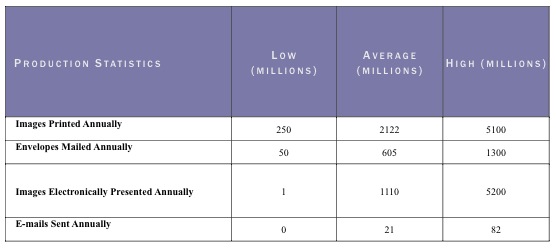The transactional print market is under intense price
pressure. Organizations consider print operations to be a cost center that is
not part of a core business operation. As a result, organizations evaluate
internal operations with a goal of reducing costs or outsourcing the operation.
Service providers, also under price pressure, seek to streamline production
operations and support a broader range of services, such as multi-channel
delivery. While many core applications, such as statements and policies, resist
transition to electronic media, many of the ancillary applications that
provided higher profit margins for print service providers have seen greater
electronic delivery adoption rates. Yet, despite this transition, many large
service providers cannot articulate standard pricing models for electronic
services.
Industry Trends
Madison Advisors recently published the third edition of its
"Service Provider Market Pricing Study," which examines pricing models and trends
for a range of transactional print and electronic delivery services. Typically,
service providers receive electronic files from clients, which they print and
insert into envelopes. Most service providers also submit documents to the post
office or a presort operation for co-mingling with other clients' mail to
reduce postage costs. Service providers may also offer document archiving and
electronic presentment of the printed documents to complete the document
life cycle.
Participants in the study included national and regional service
providers in North America. The following table provides production statistics
for the participating service bureaus.

— Service Provider Annual Production Statistics
During conversations with participants and discussions with
organizations evaluating outsourcing options, Madison Advisors identified
several trends evolving in the print and mail industry.
Multi-Channel Delivery
E-delivery mechanisms, such as email, web presentment and
text messaging, enable organizations to communicate more efficiently. Nearly
all of the participating service providers offer a number of alternatives to
printed communications, due to demand for lower cost communications. For many
print operations, postage paid on an envelope represent half of the overall
cost to produce a document.
In response to customer demand, print service providers have
built robust electronic delivery systems that support high volumes of
electronic presentment, as well as email and text message delivery. Madison
Advisors' research found increasing volumes of email and text messaging,
although they are still considerably smaller than existing postal mail volumes.
On average, emails represent 12% of the communications sent by
service providers and text messages represent three percent.
Customer Portals
Web-based portals allow clients to monitor the current
status of jobs, generate production reports for evaluation of service-level
agreements (SLAs) and control marketing content. In addition, customer portals
provide service providers both an option for enhanced customer service as well
as an opportunity for additional service offerings. The portal software routes
customer communications to the appropriate individual and re-routes inquiries
if the initial recipient is unavailable.
Service providers offer value-added services through
customer portals. For example, several document composition vendors provide
web-based user interfaces that allow content owners, such as marketing
departments, to create and embed messages into documents without disrupting the
document's layout. Service providers embed these interfaces into their customer
portals allowing clients to manage content and marketing messages through the
portal interface.
Job Workflow
Several service providers identified changes to their
workflow processes driven by an opportunity to expand their customer base
down-market to customers with lower print volumes. Over the past few years as
print capacity has remained strong and demand has decreased, service providers
in general have been challenged to maintain growth.
Madison Advisors found that service providers need to
simplify workflow processes to lower overhead and offer production services to
new customers with smaller print volumes. Oftentimes, service providers
required large print volumes to offset the expense of implementing new customer
applications. Simplifying the workflow and reducing the overhead enables the
service provider to remain profitable with smaller print jobs.
Madison Advisors expects more service providers to adopt new
onboarding processes that will allow client files to flow into production
without upfront programming. Madison Advisors' survey found that, on average,
clients provide pre-composed files for almost 40% of the jobs
received by the participating service providers. As more clients implement
their own document composition tools and deliver pre-composed files, the
service providers need to bring these customer jobs into a production factory
without pre-existing factory controls.
Market Pricing
The transactional market consists of large-volume batch
documents, including statements and invoices, which are typically produced on a
daily, weekly or monthly production cycle. Transactional documents contain
personal financial or medical data that requires secure handling and accurate
delivery. Madison Advisors collected data for over 100 services, of
which only a small sample are provided below.
No one service provider offers the lowest prices for every
category. Providers offer a significant range of prices depending on both
volume and vertical markets with emphases on specific verticals. For example,
several providers prefer to bundle the print and insertion pricing into a
single price per sheet for a job.
Continuous duplex printing
represents the most common form of digital print for transactional
applications. For the financial services application (statements), the per
image pricing ranged from $0.0100 to $0.0473. The average price increased from
$0.0169 per image in 2008 to $0.0226 per image in 2011. Madison Advisors
believes that the increased price comes from increased regulations and security
processes associated with financial printing.
A number of service providers have implemented color inkjet
printing systems. Again in financial services, the full-color inkjet print
price per image ranged from $0.0153 to $0.02. The average price per image for
inkjet hovers around $0.06 whereas the same images produced on color laser
systems range from 20% to 90% higher. The price
difference reflects the difference in consumables costs. Since inkjet systems
have evolved to support non-specialty stocks, the materials costs for inkjet
have dropped.
Automated insertion represents the other core production
service. While some service providers bundle print and insertion, most broke
out pricing for our study. For example, automated insertion of a four-page
financial statement ranged from $0.0250 to $0.1259, not including additional
materials, such as marketing inserts or business reply envelopes.
Many service providers offer manual flats insertion for
documents greater than 100 pages and box insertion for very large documents. As
compared to 2008 pricing, the range between the high and low prices for most
categories have become tighter and the average prices dropped by 25%. Even the most highly automated service bureaus provide some manual
processing for very high-page-count items or very small jobs, such as reprint
runs.
Madison Advisors collected data on a number of electronic
delivery services. Most service providers use an implementation and monthly fee
model. The implementation covers the initial system setup and the development
of one or more documents. In some cases, this fee is calculated using a set
number of programming/development hours.
Madison Advisors found that pricing for the initial setup
fee varied widely depending on the size of the client and the volume of print
associated with the proposal. Although most providers do price electronic
presentment services as a separate offering, these services come bundled with a
print/mail proposal. These solutions may also include discounted programming
services and set up of additional documents at a lower rate.
Email represents the most common form of electronic
delivery with prices ranging from $0.03 to $0.08 for processing and delivery of
a PDF document via email. Most providers do not break out the charges into
separate components but rather quote one charge for both. Loading fees
typically go down as monthly volume increases.
Overall, Madison Advisors found that prices for established
services, such and print and insertion, remain relatively stable, while prices
for newer services, such as messaging and multi-channel delivery, have less
variances than in 2008.
RICHARD HUFF is a
principal analyst with Madison Advisors, an advisory firm that specializes in
print and electronic communications. He provides project-based advisory
services designed to assist clients with business strategy and technology
selection decisions. For more information on Madison Advisors, visit www.madisonadvisors.com.










